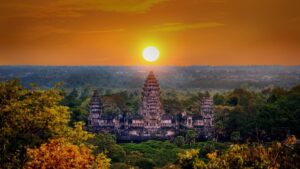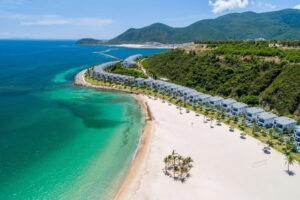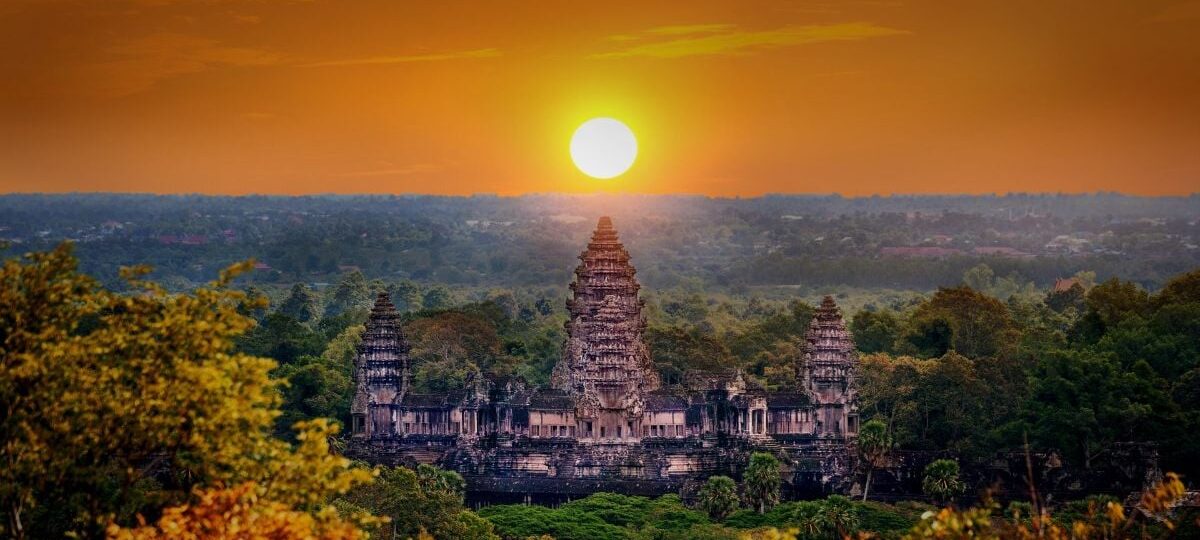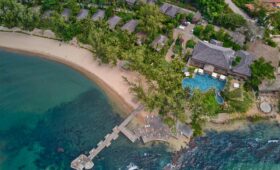1. Introduction
Vietnam and Cambodia are two prominent destinations in Southeast Asia, famous for their harmonious blend of nature, cultural heritage, and colorful indigenous life. Vietnam stretches over 3,000 km of coastline, possessing landscapes from the majestic Northwestern mountains to the rich Mekong Delta, while Cambodia is captivating with the majestic Angkor Wat complex, unique floating villages, and peaceful beaches in Sihanoukville.
However, each season of the year in these two countries has its own climate and beauty. Choosing the best time to visit Vietnam and Cambodia will help you maximize your experience – from enjoying the beautiful weather and taking impressive photos to participating in traditional festivals.
2. General climate characteristics of Vietnam and Cambodia
Both Vietnam and Cambodia are in the tropical monsoon climate zone with two distinct seasons: dry season and rainy season.
The dry season usually lasts from November to April of the following year, with dry weather, mild temperatures, and clear skies, which are very favorable for outdoor activities. The rainy season lasts from May to October, characterized by short but heavy showers, which help cool the air and make the landscape more lush.
In Vietnam, the climate is differentiated by region. The North has four distinct seasons; the Central region is hot all year round, but from September to November there are often storms; the South is warm all year round; and the dry season is the best time to explore Saigon, the Mekong Delta, and Phu Quoc.
Cambodia has a more stable climate with temperatures ranging from 21°C to 35°C: The dry season in Cambodia brings clear skies and low humidity, which is very convenient for visiting the Angkor Wat complex or taking a boat trip on the Tonle Sap Lake. Although the rainy season has frequent rains, mainly in the afternoon or evening, the morning is still suitable for exploring activities.

Saigon is a vibrant city of Vietnam, each season has its own unique beauty. (Source: internet)
3. Dry Season – The perfect choice for most tourists (November – April)
The dry season is usually considered as the best time to visit Vietnam and Cambodia. Clear skies, low rainfall, and mild temperatures create great conditions for outdoor activities.
3.1. Dry season in Vietnam
From November to March, Vietnam enters the most beautiful season for tourism. The North has a cool climate, ideal for leisurely strolls in Hanoi’s Old Quarter, mountain climbing in Sa Pa, or moments of watching the mist lingering on Fansipan peak.
Central Vietnam is now calm and sunny, very suitable for swimming in Da Nang, relaxing in the ancient space of Hoi An, or exploring the cultural heritage in Hue. Meanwhile, the South is dry and pleasant, opening up the opportunity to fully experience the vibrant life in Ho Chi Minh City, stroll the floating market in the West, or luxuriously relax on the pearl island of Phu Quoc.

The dry season is the ideal time for climbing Fansipan Mountain, Sapa, Vietnam. (Source: internet)
3.2. Dry season in Cambodia
Cambodia also welcomes the most beautiful tourist season during this period. Angkor Wat has dry roads that are convenient for traveling, and the Phnom Penh and Sihanoukville areas bring cool, pleasant weather, suitable for combining cultural exploration and enjoying days of relaxation on the blue sea.
This season has stable weather, little rain, and favorable conditions for all types of tourism, from trekking and cultural exploration to beach resorts. However, this is the peak season, so service prices increase and there are many visitors, air tickets and hotels should be booked 2-3 months in advance to have a good choice.

Strange story at Angkor Wat wonder: The sun reaches its peak exactly twice a year (March and September) (Source: internet)
4. Rainy Season – time for peace and green (May – October)
If you like the fresh scenery and more reasonable travel costs, the rainy season is the best time to visit Vietnam and Cambodia. Rain often appears in the afternoon or evening, leaving cool mornings and fresh air.
Vietnam in the summer brings the terraced fields in Mu Cang Chai and Sa Pa, green or shimmering during the flooding season, creating a mesmerizing reflection. Central beaches such as Nha Trang or Quy Nhon still retain their brilliant beauty from May to August, before entering the storm season.
In Cambodia, Tonle Sap Lake in the flooding season is vast, ideal for experiencing a boat trip through floating villages and flooded forests. Angkor Wat on rainy days with few visitors reflects on the lake surface, bringing a rare magical beauty.
This season has cheaper costs, flexible services, and fewer visitors, making it easier for you to enjoy private space at famous spots. However, you need to prepare raincoats and non-slip shoes and arrange a reasonable schedule to avoid heavy rains.

Nha Trang has beaches that captivate domestic and international tourists. (Source: internet).
5. Golden Time for Festival Experience
In addition to the weather, festivals are also an important factor in choosing the best time to visit Vietnam and Cambodia, especially if you want to immerse yourself in the local cultural life.
5.1. Vietnam
Tet Nguyen Dan (January – February): The biggest traditional New Year celebration in Vietnam, lasting for many days and taking place across the country. Visitors can visit Tet flower markets, enjoy traditional dishes, watch lion dances, and participate in the first temple festival of the year.
Tet Trung Thu (August of the lunar calendar): A full moon festival for children and families, featuring lanterns and moon cakes. Visitors can stroll around the lantern streets, watch lion dances, and participate in making cakes or handmade lanterns.
Huong Pagoda Festival (January – March of the lunar calendar): The largest pilgrimage festival in the North, held at the Huong Pagoda complex in Hanoi. Visitors will take a boat ride on Yen Stream, climb mountains to visit Huong Tich Cave, and participate in lucky rituals.

Huong Pagoda Festival – A unique beauty of Northern Vietnam. (Source: internet)
5.2. Cambodia
Chol Chnam Thmay (April): The traditional Khmer New Year marks the new year according to the solar calendar. Visitors can participate in water splashing ceremonies, watch Apsara dances, play folk games, and visit splendidly decorated pagodas.
Bon Om Touk (November): Cambodia’s biggest water festival, celebrating the changing flow of the Tonle Sap River. Visitors can watch dragon boat races, enjoy street food, and attend riverside music events.

The unique Bon Om Touk water festival in Cambodia every November. (Source: internet)
6. Suggested best time to visit Vietnam and Cambodia according to interests
Love the beach and the sun: December to April is the dry season in southern Vietnam and Cambodia, with clear skies and calm seas, making it ideal for a holiday in Phu Quoc, Nha Trang, or Sihanoukville. This is also the perfect time to go snorkeling, kayaking, or relaxing on the white sand and enjoying fresh seafood.
Passion for terraced field photography: From September to October, the mountainous regions of Northern Vietnam (Sa Pa, Mu Cang Chai, and Hoang Su Phi) enter the golden rice harvest season. Visitors can hunt for spectacular photos, explore local culture, and visit colorful highland markets.
Avoid the crowds: The rainy season from May to October has fewer visitors, reasonable costs, and lush nature. Short rains create full waterfalls and cool air, suitable for those who like slow and quiet travel.
Discover festivals: The time of Tet in Vietnam (January-February) or Chol Chnam Thmay in Cambodia (April) is an opportunity to immerse yourself in the brilliant festivals, admire the decorated streets, and enjoy many unique traditional activities.
7. Conclusion
The best time to visit Vietnam and Cambodia will vary depending on your preferences, budget, and travel goals. No matter which season you choose, the trip promises to bring unforgettable experiences, from breathtaking natural landscapes to unique cultural depth. To make your trip more complete, join Asia Luxury Travel—a unit that provides quality travel itineraries and dedicated services.
8. Contact :
Phone: +84 965 721 426
Email: sales@asialuxurytravels.com
Website: https://asialuxurytravels.com/
Address: No. 9, Alley 31/7, Phan Dinh Giot Street, Thanh Xuan, Hanoi





